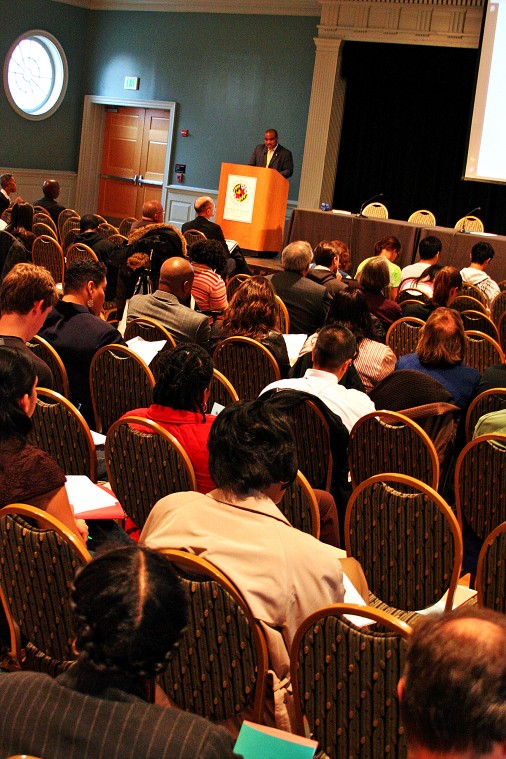Students, faculty and staff came to the diversity town hall meeting in droves yesterday to make one point very clear: The language of the diversity plan’s draft is flawed, and they’re not satisfied.
Though many were enthusiastic about the diversity plan as a concept, audience members identified what they said were holes in the first draft of the Diversity Strategic Plan. Students complained graduate students, international students and students with disabilities were shortchanged; faculty questioned the committee about diversity of thought and the plan’s staying power and language; and staff members demanded equal representation.
Assistant to the President for Diversity and Equity Rob Waters, who chaired the committee, said the plan’s intent was to be all-inclusive.
“We want to create a plan in which everyone in the university sees themselves,” Waters said, opening the town hall. “If you don’t see yourself in this document, tell us that.”
But for about two hours straight, speaker after speaker took to the microphone and said they didn’t feel represented in the 18-page document.
“We have a wish list here, but I want to see some outcomes,” graduate student Angel Miles said, after demanding more specificity about issues facing disabled populations on the campus.
Student leaders also reiterated their concerns from Friday’s Multicultural Involvement and Cultural Advocacy Fifth Annual Leadership Summit, including issues with the creation of a diversity office and the appointment of a chief diversity officer. Many questioned how much authority this new person would have and how the department would be funded.
Some attendees said they would believe the draft’s promises when they materialize.
“We’ve seen reports like these come and go, and I hope this is not another one that will just come and go,” American Studies Chair Nancy Struna said. “I would ask if the committee would reconsider whether diversity is just another series of goals or if it is a dimension of excellence and if so, how do we make sure it’s rewarded and ensure that for the rest of my lifetime here we finally get it right?”
Others said the very language used in the document was insufficient and misrepresentative of its goals.
“In terms of language in the diversity plan I would like to encourage you to think about the terms ‘cultivating and sustaining diversity,’ rather than ‘managing or organizing diversity,'” Vice President of the Black Faculty and Staff Association Wallace Southerland said. “An authentic pursuit of authentic diversity requires authentic accountability.”
The five committee members who answered questions — Waters, Behavioral and Social Sciences Assistant Dean Kim Nickerson, Asian American Studies Department Chair Larry Shinagawa, women’s studies professor Ruth Zambrana and student union Director Gretchen Metzelaars — were all chairs of different subcommittees that authored the various parts of the plan. They countered questions and criticisms by emphasizing the document was merely a draft, repeating they would revisit the plan after the town hall and incorporate their constituents’ suggestions.
While the provost has said he would like to see a final plan by the end of the academic year, Waters is urging the committee to come up with a completed version by the end of the semester.
One of the persisting problems, Waters said, was simply defining what diversity does — and should — signify.
“It’s an age old question, and we’re still trying to figure it out,” Waters said. “We haven’t quite collaborated, ‘We want our student body to look like X, we want our faculty to look like X.’ What diversity means and what diversity is important may be different things to different groups.”
Nickerson concurred.
“We just don’t have the language to be able to properly dissect the big diversity pie,” he said.
Though comments, questions and suggestions were limited to two minutes each, the committee appeared willing to listen. They took notes throughout the meeting, collected documents from students, faculty and staff members and asked the more than 300 people in attendance fill out anonymous feedback forms.
This forum came on the coattails of last semester’s diversity forum where students voiced their outrage at what they felt was a disregard for their opinions.
But while there was an outpouring of feedback from the audience, Metzelaars said, in many ways, the town hall was a forum for preaching to the choir.
“The people in this room are those that care about diversity because they are a part of it,” she said. “This is not the majority — the majority of people are not here.”
Apart from student leaders and a few university staff, the audience was mostly made up of those from underrepresented communities who were engaged in diversity issues or organizations. This widespread apathy towards diversity issues, Metzelaars said, could eventually endanger the overall success of the plan.
“I wonder if they care,” she said. “I question whether they’re even listening.”
hampton@umdbk.com, mlang@umdbk.com





